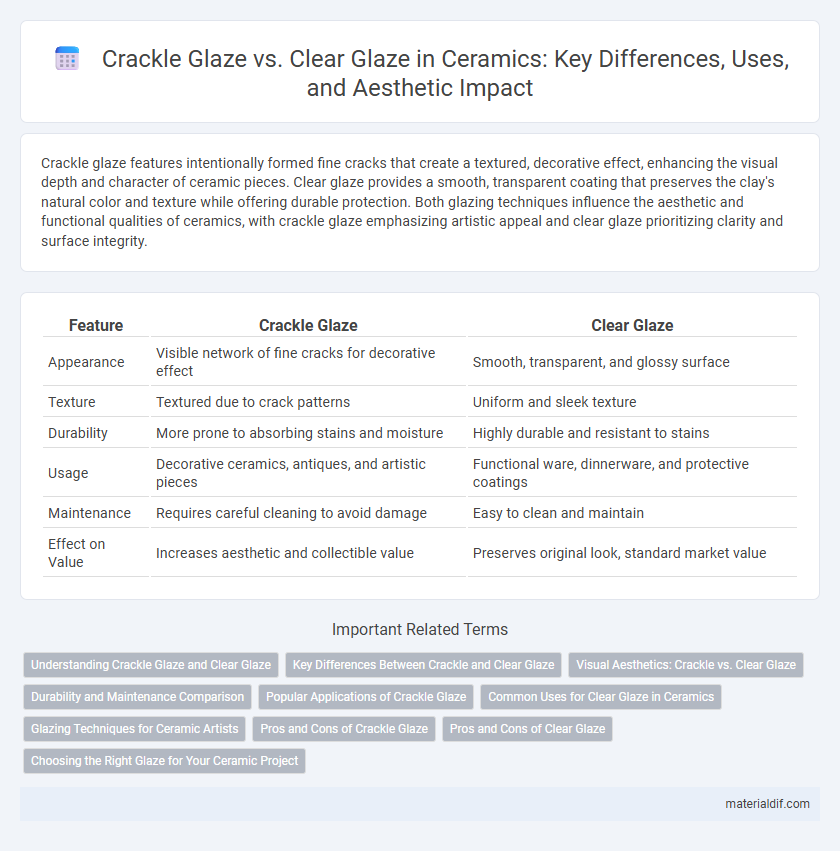Crackle glaze features intentionally formed fine cracks that create a textured, decorative effect, enhancing the visual depth and character of ceramic pieces. Clear glaze provides a smooth, transparent coating that preserves the clay's natural color and texture while offering durable protection. Both glazing techniques influence the aesthetic and functional qualities of ceramics, with crackle glaze emphasizing artistic appeal and clear glaze prioritizing clarity and surface integrity.
Table of Comparison
| Feature | Crackle Glaze | Clear Glaze |
|---|---|---|
| Appearance | Visible network of fine cracks for decorative effect | Smooth, transparent, and glossy surface |
| Texture | Textured due to crack patterns | Uniform and sleek texture |
| Durability | More prone to absorbing stains and moisture | Highly durable and resistant to stains |
| Usage | Decorative ceramics, antiques, and artistic pieces | Functional ware, dinnerware, and protective coatings |
| Maintenance | Requires careful cleaning to avoid damage | Easy to clean and maintain |
| Effect on Value | Increases aesthetic and collectible value | Preserves original look, standard market value |
Understanding Crackle Glaze and Clear Glaze
Crackle glaze features a network of fine cracks on the ceramic surface, creating a textured, antique appearance valued for its aesthetic complexity and visual depth. Clear glaze offers a smooth, transparent coating that enhances the underlying clay or decoration, providing durability and a glossy finish without altering the ceramic's original color. Understanding these differences helps ceramic artists choose the right glaze to achieve either a traditional, aged look with crackle glaze or a clean, polished appearance with clear glaze.
Key Differences Between Crackle and Clear Glaze
Crackle glaze features intentional network-like cracks on the surface, creating a textured, decorative finish that enhances the visual complexity of ceramics, while clear glaze is smooth and transparent, emphasizing the natural color and form of the clay body. Crackle glaze often involves controlled crazing as part of the kiln cooling process, whereas clear glaze provides a uniform, glossy coating that offers durability and water resistance without altering the underlying texture. The choice between crackle and clear glaze significantly impacts both the aesthetic appeal and functional qualities of ceramic pieces.
Visual Aesthetics: Crackle vs. Clear Glaze
Crackle glaze features a network of fine, intentional cracks on the surface, creating a textured, antique appearance that adds depth and character to ceramics. Clear glaze provides a smooth, glossy finish that enhances the natural color and detail of the clay body without interrupting the surface. The choice between crackle and clear glaze significantly impacts the visual aesthetics, with crackle glaze emphasizing artistic complexity and clear glaze prioritizing clarity and vibrancy.
Durability and Maintenance Comparison
Crackle glaze features a network of fine cracks that create a unique decorative effect but can compromise durability by allowing moisture and dirt to penetrate, requiring more careful maintenance to prevent staining and damage. Clear glaze offers a smooth, impermeable surface that provides superior durability and easier cleaning, making it ideal for high-use ceramics. Choosing between crackle and clear glaze depends on the balance between aesthetic preference and practical requirements for long-term durability and upkeep.
Popular Applications of Crackle Glaze
Crackle glaze is widely used in decorative ceramics, such as vases, tiles, and pottery, for its distinctive network of fine cracks that enhance visual texture and create an antique or rustic look. This glaze technique is especially popular in traditional Asian ceramics, where it adds depth and character to porcelain and stoneware pieces. Unlike clear glaze, which provides a smooth, glossy, and transparent finish, crackle glaze intentionally introduces crazing patterns, making it a favored choice for artistic and ornamental applications.
Common Uses for Clear Glaze in Ceramics
Clear glaze is frequently used in ceramics to create a glossy, transparent surface that enhances the underlying clay body or decorative motifs. It provides a durable, waterproof finish suitable for functional ware like plates, bowls, and vases. This glaze preserves the clay's natural color and texture while offering protection against stains and scratches.
Glazing Techniques for Ceramic Artists
Crackle glaze creates a network of fine surface cracks that enhance texture and visual interest, ideal for achieving an antique or rustic aesthetic. Clear glaze provides a smooth, glossy finish that highlights the clay body and any underlying decoration, preserving color vibrancy and surface details. Ceramic artists often select crackle glaze for its decorative complexity, while clear glaze is favored for protection and clarity in glazing techniques.
Pros and Cons of Crackle Glaze
Crackle glaze offers a distinctive textured pattern that enhances the aesthetic appeal of ceramic pieces with a network of fine surface cracks. This decorative effect adds character and visual interest but can compromise the glaze's durability, making it more prone to staining and moisture absorption. While crackle glaze excels in artistic applications, it requires careful sealing and maintenance compared to the smooth, non-porous surface provided by clear glaze.
Pros and Cons of Clear Glaze
Clear glaze offers a smooth, glossy finish that enhances the natural color and texture of ceramic pieces while providing a waterproof and durable surface that resists stains and scratches. However, its transparent nature can reveal imperfections in the clay body or firing process, making flaws more noticeable compared to crackle glaze. Clear glaze tends to be less visually complex than crackle glaze, which may result in a more subdued aesthetic for artists seeking intricate surface patterns.
Choosing the Right Glaze for Your Ceramic Project
Crackle glaze creates a network of fine cracks on the ceramic surface, adding a vintage or textured aesthetic ideal for decorative pieces, while clear glaze offers a smooth, glossy finish that enhances the color and detail of the clay body beneath. Choosing the right glaze depends on your project's purpose: crackle glaze is best for artistic effects and visual interest, whereas clear glaze provides durability and a clean, polished look suitable for functional ware. Consider the firing temperature compatibility and the clay type, as both glazes perform differently depending on these factors.
Crackle Glaze vs Clear Glaze Infographic

 materialdif.com
materialdif.com